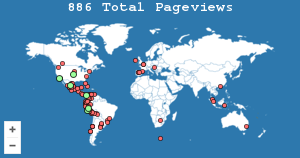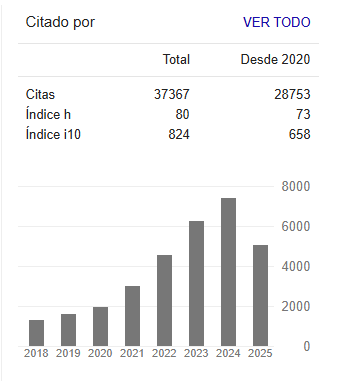Innovación abierta y rendimiento financiero en la industria manufacturera de México
Resumen
La presente investigación tiene como objetivo analizar la influencia que tiene la innovación abierta en el desempeño financiero de la industria manufacturera de México, para ello se realizó un estudio empírico con una muestra de 300 pequeñas y medianas empresas con un enfoque cuantitativo a través de la aplicación de un modelo de ecuaciones estructurales, el cual es uno de los métodos más adecuados para el análisis de dependencia. Si bien es cierto, que la innovación abierta es un constructo relativamente reciente en la actual literatura del marketing, también es cierto que es considerada por diversos investigadores, académicos y profesionales del campo de la innovación, como la estrategia empresarial que genera un mayor nivel de rendimiento financiero a las empresas que la han implementado. Los resultados obtenidos en este estudio empírico muestran que la innovación abierta ejerce un efecto positivo significativo en el rendimiento financiero de las empresas de la industria manufacturera de México, por lo cual es posible concluir, que las empresas que adopten la innovación abierta, tendrán mayores posibilidades de lograr un incremento significativo en su rendimiento financiero.Citas
Ahn, Joon, Mo; Minshall, Tim y Mortara, Letizia (2015), Open innovation: A new classification and its impact on firm performance in innovative SMEs. Journal of Innovation Management, Año 2, No. 3, pp 33-54.
Ahn, Joon, Mo; Mortara, Letizia y Minshall, Tim (2013), The effects of open innovation on firm performance: A capacity approach. STI Policy Review, Año 1, No. 4, pp 74-93.
Anderson, James y Gerbing, David (1988), Structural equation modeling in practice: a review and recommended two-step approach. Psychological Bulletin, Año 1, No. 13, Sejong, Korea, Science and Technology Policy Institute, pp 411-423.
Atuahene-Gima, Kwaku (2005), Resolving the capability: Rigidity paradox in new product innovation author(s). Journal of Product Innovation Management, Año 3, No. 23, Nueva York, Estados Unidos, Sage Publications, pp 27-47.
Bagozzi, Richard y Yi, Youjae (1988), On the evaluation of structural equation models. Journal of the Academy of Marketing Science, Año 1, No. 16, Berlin, Alemania, Springer-Verlag, pp 74-94.
Bentler, Peter (2005), EQS 6 Structural Equations Program Manual. California, Multivariate Software, pp 422.
Brown, Timothy (2006), Confirmatory Factor Analysis for Applied Research. Nueva York, The Guilford Press, pp 493.
Byrne, Barbara (2006) Structural Equation Modeling With EQS, Basic Concepts, Applications, and Programming. Londres, LEA Publishers, pp, 429.
Caloghirou, Yannis; Ioanna, Kastelli y Aggelos, Tsakanikas (2004), Internal capabilities and external knowledge sources: Complements or substitutes for innovation performance? Technovation, Año 1, No. 24, Atenas, Grecia, National Technical University of Athens, pp 29-39.
Caputo, Mauro; Lamberti, Emilia; Cammarano, Antonello y Michelino, Francesca (2016), Exploring the impact of open innovation on firm performance. Management Decision, Año 7, No. 54, Reino Unido, Emerald Group Publishing Ltd, pp 1789-1812.
Chaston, Ian, y Gregory J. Scott (2012), Entrepreneurship and open innovation in an emerging economy. Management Decision, Año 7, No. 50, Reino Unido, Emerald Group Publishing Ltd, pp 1161-1177.
Chesbrough, Henry, William (2003a), The era of open innovation. MIT Sloan Management Review, Año 3, No. 44, Estados Unidos, Massachusetts Institute of Technology pp 35-41.
Chesbrough, Henry, William (2003b), Open Innovation. Cambridge, Massachusetts, Harvard University Press.
Chesbrough, Henry, William (2006), Open Business Models: How to Thrive in the New Innovation Landscape. Boston, Massachusetts, Harvard Business School Press.
Chesbrough, Henry, William y Adrienne, Kardon, Crowther (2006), Beyond high-tech: Early adopters of open innovation in other industries. RyD Management, Año 3, No. 36, Oxford, Reino Unido, John Wiley & Sons, pp 229-236.
Christensen, Jens, Frøslev; Michael, Holm, Olesen y Jonas, Sorth, Kjær (2005), The industrial dynamics of open innovation: Evidence from the transformation of consumer electronics. Research Policy, Año 10, No. 34, Holanda, Elsevier B.V, pp1533-1549.
Cohen, Wesley y Daniel, Levinthal (1990). Absorptive capacity: A new perspective of learning and innovation. Administrative Science Quarterly, Año 1, No. 35, Estados Unidos, Sage Publications, pp 128-152.
Cooper, Robert (2008), The stage-gate idea-to-lunch process: Update, what’s new and NexGen systems. Journal of Product Management, Año 3, No. 25, Canadá, pp 213-232.
Dahlander, Linus, y Gann, David (2010), How open is innovation? Research Policy, Año 6, No. 39, Holanda, Elsevier B.V, pp 699-709.
Du, Jingshu; Leten, Bart y Vanhaverbeke, Wim (2014), Managing open innovation projects with science-based and market-based partners. Research Policy, Año 5 No. 43, Holanda, Elsevier B.V, pp 828-840.
Faems, Dries; De Visser, Matthias; Andries, Petra y Van Looy, Bart (2010), Technology alliance portfolios and financial performance: Value-enhancing and cost-increasing effects of open innovation. Journal of Product Innovation Management, Año 6, No. 27, Estados Unidos, Sage Publications, pp 785-796.
Fasnacht, Daniel (2009), Open Innovation in the Financial Services. Berlin, Heidelberg: Springer-Verlag.
Fornell, Claes y Larcker, David (1981), Evaluating structural equation models with unobservable variables and measurement error. Journal of Marketing Research, Año 1, No. 18, Chicago. United States, Cambridge University Press, pp. 39-50.
Fosfuri, Andrea (2006), The licensing dilemma: Understanding the determinants of the rate of technology licensing. Strategic Management Journal, Año 12, No. 27, Estados Unidos, John Wiley & Sons Inc. pp 1141-1158.
Gambardella, Alfonso; Giuri, Paola y Luzzi, Alessandra (2007), The market for patents in Europe. Research Policy, Año 1, No. 36, Holanda, Elsevier B.V, pp 1163-1183.
Greco, Marco; Grimaldi, Michele y Cricelli, Livio (2015), Open innovation actions and innovation performance: A literature review of European empirical evidence. European Journal of Innovation Management, Año 2 No. 18, Reino Unido, Emerald Group Publishing Ltd, pp 150-171.
Grimpe, Christoph y Sofka, Wolfgang (2009), Search patterns and absorptive capacity: Low-and-high-technology sector in European countries. Research Policy, Año 3, No. 38, Dinamarca, 495-506.
Hair, Joseph, Anderson, Rolph, Tatham, Ronald y Black, William (1995). Multivariate Data Analysis with Readings. New York. Prentice-Hall, pp. 761.
Hatcher, Larry (1994). A Step-by-Step Approach to Using the SAS System for Factor Analysis and Structural Equation Modeling. North Carolina, SAS Institute Inc, pp 429.
Henkel, Joachim (2006), Selective revealing in open innovation processes: The case of embedded Linux. Research Policy, Technische Universität München, Alemania, Año 7, No. 35, pp 953-969.
Huizingh, Eelko H (2011), Open innovation: State of the art and future perspectives. Technovation, University of Groningen, Paises Bajos, Año 1, No. 31, pp 2-9.
Hung, Kuang-Peng y Chiang, Yun-Hwa (2010), Open innovation proclivity, entrepreneurial orientation and perceived firm performance. International Journal of Technology Management, Año3/4, No. 52, Taiwan, pp 257-274.
Huston, Larry y Sakkab, Nabil (2006), Connect and develop: Inside Procter y Gamble’s new model for innovation. Harvard Business Review, Año 3, No. 84, , Estados Unidos de America, pp 58-66.
Hwang, Junseok y Lee, Youngjin (2010), External knowledge search, innovative performance and productivity in the Korean ICT sector. Telecommunications Policy, Año 10, No. 34, Corea del sur, pp 562-571.
Ili, Serhan; Albers, Albert y Miller, Sebastian (2010), Open innovation in the automotive industry. RyD Management, Año 3, No. 40, Alemania pp 246-255.
Keupp, Marcus Matthias y Gassmann, Oliver (2009), Determinants and archetype users of open innovation. RyD Management, Año 4, No. 39, Alemania, pp 331-341.
Koellinger, Philipp, D (2008), The relationship between, technology, innovation, and firm performance: Empirical evidence from e-business in Europe. Research Policy, Año 8, No. 37, Holanda, pp 1317-1328.
Koput, Kenneth, W (1997), A chaotic model of innovative search: Some answers, many questions. Organizational Science, Año 5, No. 8, Estados Unidos de America, pp 528-542.
Laursen, Keld y Salter, Ammon J (2006), Open for innovation: The role of openness in explaining innovation performance among UK manufacturing firms. Strategic Management Journal, Año 1, No. 27, Reino Unido, pp 131-150.
Lazzarotti, Valentina; Manzini, Raffaella y Pellegrini, Luisa (2010), Open innovation models adopted in practice: An extensive study in Italy. Measuring Business Excellence, Año 4, No. 14, Carlo Cattaneo University LIUC, Italia, pp 11-23.
Lichtenthaler, Ulrich (2007), The drivers of technology licensing: An industry comparison. California Management Review, International School of Management, Año 4, No. 49, Alemania, pp 67-89.
Lichtenthaler, Ulrich (2008), Open innovation in practice: An analysis for strategic approaches to technology transactions. IEEE Transactions on Engineering Management, International School of Management, Año 1, No. 55, Alemania, pp 148-147.
Lichtenthaler, Ulrich (2009), Outbound open innovation and its effects on firm performance: Examining environmental influences. RyD Management, Año 4. No. 39, International School of Management, Alemania, pp 317-330.
Lichtenthaler, Ulrich (2015), A note on outbound open innovation and firm performance. RyD Management, Año 5, No. 45, International School of Management, Alemania, pp 606-608.
Lichtenthaler, Ulrich y Ernst, Holger (2009), Opening up the innovation process: The role of technology aggressiveness. RyD Management, Año 1, No. 39, International School of Management, Alemania, pp 38-54.
Linstone, Harold (2010), Comment on is open innovation a field of study or a communication barrier to theory development? Technovation, Año 11/12 No. 30, Estados Unidos de America, pp 556-566.
March, James, G (1991), Exploration and exploitation in organizational learning. Organization Science, Año 1, No. 2, Estados Unidos de America, pp 71-87.
Miotti, Luis, Egidio y Sachwald, Frederique (2003), Co-operative RyD: Why and with whom? An integrated framework of analysis. Research Policy, Año 8, No. 32, Francia,pp 1481-1499.
Mowery, David, C (2009), Plus can change: Industrial RyD in the third industrial revolution. Industrial and Corporate Change, Año ١, No. ١٨, University of California, Estados Unidos de America, pp 1-50.
Noh, Yonghwi (2015), Financial effects of open innovation in the manufacturing industry. Management Decision, Año 7, No. 53, Myongji University, Corea del sur,pp 1527-1544.
Nunally, Jum y Bernstein, Ira (1994). Psychometric Theory. New York. McGraw-Hill. Pp.736.
Ocasio, William (1997), Towards an attention-based view of the firm. Strategy Management Journal. Año S1, No.18, Northwestern University, Estados Unidos de America, pp 187-206.
Pisano, Gary, P (1990), The RyD boundaries of the firm: An empirical analysis. Administration Science Quarterly, Año 3, No. 35, Estados Unidos de America, pp 153-176.
Rosenbusch, Nina; Brinckmann, Jan y Bausch, Andreas (2011), Is innovation always beneficial? A meta-analysis of the relationship between innovation and performance in SMEs. Journal of Business Venturing, Año 4, No. 26, Alemania, pp 441-457.
Rothaermel, Frank T y Alexandre, Maria, Tereza (2009), Ambidexterity in technology sourcing: The moderating role of absorptive capacity. Organizational Science, Año 4 No. 20, Atlanta, Estados Unidos de America, pp 759-780.
Schroll, Alexander y Mild, Andreas (2012), A critical review of empirical research on open innovation adoption. Journal für Betriebswirtschaft, Año 2, No. 62, Austria, pp 85-118.
Schumpeter, Joseph A (1942), Capitalism, Socialism, and Democracy. London: Unwin University Books, pp 1-431
Teirlinck, Peter y Poelmans, Eline (2012), Open innovation and firm performance in small-sized RyD active companies in the chemistry industry: The case of Belgium. Journal of Business Chemistry, Año 3, No. 9, Universidad en Lovaina, Bélgica, pp 117-132.
Tsai, Kuen, Hung y Wang, Jiann Chyuan (2008), External technology acquisition and firm performance: A longitudinal study. Journal of Business Venturing, Año 1, No. 23, Taiwan, pp 91-112.
Vanhaverbeke, Wim; Duysters, Geert y Noorderhaven, Niels (2002), External technology sourcing through alliances or acquisitions: An analysis of the application-specific integrated circuits industry. Organizations Science, Año 6, No.13, Estados Unidos de America, pp 714-733.
West, Joel y Bogers, Marcel (2014), Leveraging external sources of innovation: A review of research on open innovation. Journal of Product Innovation Management, Blackwell Publishing, Año 4, No. 31, pp 814-831.
West, Joel; Vanhaverbeke, Wim y Chesbrough, Henry (2006), Open innovation: A research agenda. Open Innovation: Researching a New Paradigm. Oxford: Oxford University Press.
Zhang, Si; Yang, Delin; Qiu, Shumin; Bao, Xiang y Li, Jizhen (2018), Open innovation and firm performance: Evidence from Chinese mechanical manufacturing industry. Journal of Engineering and Technology Management, Año 1, No.48, China, pp 76-86.








.png)






























